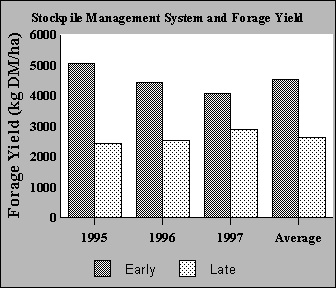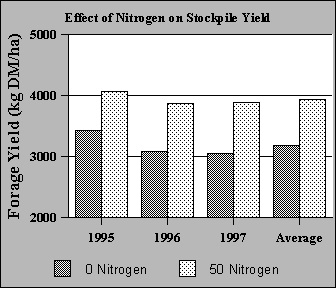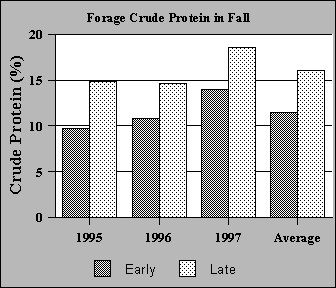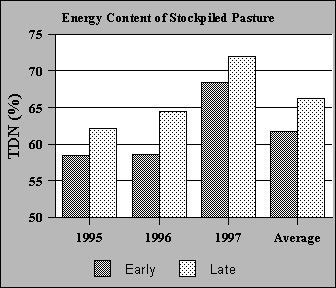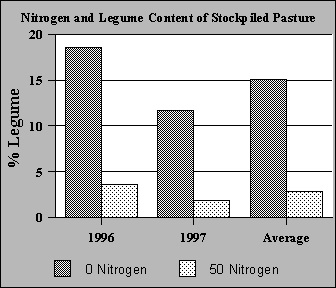Stockpiled pasture: effect of management system and nitrogen application
Learn research results from a stockpiling pasture project that looked at different management systems and nitrogen application.
Introduction
Stockpiling is the practice of saving certain hay or pasture fields for grazing in the fall and winter after forage growth has stopped due to cold weather. Stockpiled pasture is also referred to as fall-saved pasture or deferred grazing. The primary reason for using stockpiled forage is to reduce feed costs. Harvesting costs are lower for grazed forage as compared to hay or silage, manure spreading is reduced, and some overhead costs such as buildings and yards are lower. In this report, we look at the yield and quality of stockpiled pasture under two management regimes and two rates of nitrogen fertilization.
Two stockpiling management systems, called "Early" and "Late" were evaluated. In each of the three years, our experimental pastures (6 Early and 6 Late: each 0.75 acres) were cut for silage in mid-June. Following that harvest, the Early pastures were mob-grazed by sheep in mid-July for a duration of about 7 days. The Late treatments were mob-grazed in mid-August for the same duration. In both systems, the residual pasture height was about 5 cm following the mob-grazing. After the mob-grazing in summer, 3 of the Early and 3 of the Late pastures received 50 kg/ha of actual N (as 34-0-0), while the rest of the pastures did not receive nitrogen. The pastures were then left to stockpile until grazing began at the end of September.
During the fall grazing period (late September till early December), pastures were hand-sampled before and after grazing each paddock. From these samples, pasture yield, quality, and composition were determined.
Results
Forage yield
Absolute forage yields ranged from 2400 to 5000 kg/ha. The Early management system always had significantly higher dry matter yield as compared to the Late management system (Figure 1).
Averaged over the three years of the trial, the Early system provided about 73% more forage in the fall than the Late system.
Applying 50 kg/ha of nitrogen fertilizer at the start of the stockpiling period significantly increased forage yields in the fall in 1996 and 1997 only (Figure 2).
The absolute increase in forage yield from applying nitrogen averaged about 750 kg/ha. It is rather difficult to determine if that yield increase is economical under pasture conditions. However, assuming a forage value of $100/tonne of dry matter and a nitrogen cost of $0.91/kg actual N ($310/mt of 34-0-0), one would gain $75.00 worth of forage for an expenditure of about $45.00 in fertilizer plus about $5.00 for application. Urea (46-0-0) is a lower cost source of N but the risk of losses to volatilization are much higher, especially with mid-summer applications.
Forage quality
Quality measurements were made throughout the fall grazing period (late September to early December). The values reported are averages for the entire fall grazing period. In general, forage quality was higher in 1997 than in the previous two years. Crude protein levels were always significantly higher when pastures were managed under the Late stockpile system as compared to the Early stockpiling system (Figure 3).
Absolute crude protein values were sufficient for maintenance requirements of sheep or cattle under the Early system (9 to 14%) and sufficient for most growing and lactating animals under the Late system (14.5 to 18%). Applying 50 kg/ha of nitrogen to the pasture at the beginning of the stockpiling period increased the crude protein content of the pasture in 1995 but had no effect in 1996 or 1997 (data not shown).
The total digestible nutrient content (TDN) of the stockpiled forage was always significantly higher in the Late stockpile system as compared to the Early stockpile system (Figure 4).
TDN values were much higher under both systems in 1997 as compared to the previous two years, but it is unclear why this occurred. The very high TDN values shown for 1997 should be considered the exception, with the 1995 and 1996 values being more realistic on a year after year basis. Absolute values ranged from 58 to 68% under the Early system and 62 to 72% under the Late system.
Applying nitrogen to the pastures at the beginning of the stockpiling period had a small positive impact on TDN values in 1995, but made no difference in the following 2 years (data not shown).
Species composition
The original mixture sown was a complex mixture of 3 grasses and 2 legumes, with some fine grasses (bluegrass/red fescue) added to form a bottom to the pasture. Applying 50 kg/ha of nitrogen at the onset of the stockpiling period significantly decreased the legume content of the pasture as compared to not applying any nitrogen at all (Figure 5).
Even under the zero nitrogen treatment, the legume content was only about 12% of the total yield in 1997. The legume portion was mostly white clover with lesser amounts of trefoil. The legume content was lower than is normally desired in pasture, but may be satisfactory for late fall grazing. It is felt that most legumes are not suited to late fall grazing, although we do not have a good data base on this to date. More information on the value of legumes in stockpiling situations is being collected in the fall of 1998.
The stockpiling management system used had little impact on species composition with the exception of promoting higher dandelion populations in the Late stockpiling treatment (data not shown).
Summary and interpretation
The two stockpiling management systems that we imposed resulted in two quite different pastures in the fall. The Early system resulted in a large volume of medium to low quality forage while the Late system resulted in a medium yielding pasture of high quality. If the stockpiling process was initiated at an intermediate date (late July to early August), the yield and quality would be intermediate to the Early and Late systems that we examined.
Producers can manage the stockpiling process to produce the type of fall pasture that suits the nutritional requirements of their livestock. If dry, summer bred, beef cows are being pastured in the fall, then the Early system is likely the most appropriate management, whereas if weaned calves, stocker cattle, lambs, or breeding ewes are being pastured, the Late management system would be most appropriate. In many cases, both types of fall-pasture may be needed on the same farm when two classes of stock are pastured in the fall (i.e. weaned lambs and dry ewes). The key is to have a reasonably good estimate of the type (yield and quality) of forage required in the fall and to manage the stockpiling process to attain a pasture that is fairly similar to the requirements.
While nitrogen did not affect pasture quality significantly, it did increase yield and appears to be economical based on our forage yield data. The decision to apply N should also be based on soil moisture conditions and the legume content of the pasture. It is important to consider that a soil test should be taken to assess the phosphorus and potassium status of the pasture and apply these nutrients if necessary. Further studies are underway to better define the response of grasses to nitrogen applications in mid- to-late summer and to assess the effect of N applications when the forage is stored on the stem until November.
